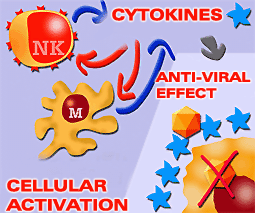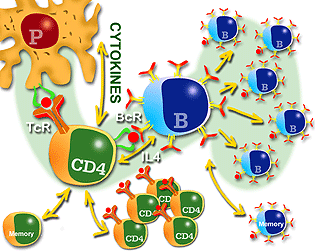| Chapter 7. Immune response activation mechanisms. Natural and adaptive response. | | | | | | | Immune response activation mechanisms. | The activation of the immune response, be it natural or adaptive, takes place due to a coordinated series of mechanisms that activate different cell populations and the secretion of different molecules, with the aim of removing the foreign agent.
| | | In previous chapters we saw that the immune system has a variety of cell populations (T and B lymphocytes, macrophages, antigen-presenting cells, NK cells, etc) and molecules (antibodies, cytokines and complement) which work together against the entry of a foreign agent. We have seen how a foreign agent has to overcome different stages to enter the organism and produce infection. Different protection mechanisms are involved in this process. | 
Phagocytosis activation occurs in four phases 1 chemotaxis, 2 adherence, 3 ingestion and 4 destruction. | It starts with physical barriers (skin, mucous secretions, proteolytic enzymes, stomach pH, etc), that cause a large number of them to be rejected. This is followed by the natural or innate response which is the first non-specific immune barrier of the pig. Through the activation of humoral factors such as the complement or cell, phagocytosis or NK cell activation, this has a high capacity of removal of infectious agents. Lastly, if it should prove necessary (it is not always needed as many infections do not develop) there is adaptive immunity, the culmination of the immune response, which owing to its specificity and memory (characteristics of the immune system) presents greater efficacy and above all enables the immune system to remember the foreign agent in future infections. | | | DEFENCE MECHANISMS | | PHYSICAL AND CHEMICAL BARRIERS | | | - SKIN
- SECRETIONS
- STOMACH pH
- ENZYMES | | NATURAL OR INNATE RESPONSE (NON-SPECIFIC IMMUNE RESPONSE) (HUMORAL AND CELL FACTORS): | | | - ALTERNATIVE COMPLEMENT PATHWAY
- PHAGOCYTOSIS
- NK CELL ACTIVATION
- CYTOKINES | ADAPTIVE RESPONSE (SPECIFIC IMMUNE RESPONSE)
(HUMORAL AND CELL FACTORS) | | | - ANTIBODIES
- CLASSIC COMPLEMENT PATHWAY
- CYTOKINES
- CYTOTOXICITY: ADCC and CD 8+ |
This chapter covers the different activation mechanisms of the immune response against the various types of infection. | | How does the immune system function during infections? If a microorganism crosses the physical (skin), chemical (pH gastric, enzymes, etc) or biological (saprophyte microorganisms in the intestine, etc) non-immune and non-specific defence barriers of an animal, , a consecutive and coordinated series of immune mechanisms (humoral and cell) are triggered to respond to the infection. The first response is mediated by the different mechanisms of the natural response which is initiated immediately after the entry of a foreign agent (4 minutes to 4 hours). | | The natural or innate response.
The natural or innate response is the first NON-SPECIFIC barrier of the immune system. It is mediated by a series of humoral (activation of the complement and certain cytokines) and cell (macrophage and NK cell activation) mechanisms which, depending on their activity sequence, can be grouped as follows: | | A.1.Complement activation. The term complement system refers to a series of plasma proteins and membrane proteins which are activated in cascade and which remove the foreign agent, either directly by microorganism lysis; or indirectly by phagocytosis of the foreign agents, inflammation activation (with the attraction of different cells and molecules which assist in removal) and the removal of the antigen-antibody immune complex. The complement is one of the most important defence mechanisms in the immune system, in both the natural and adaptive response. Its activation mechanisms can take place via the following pathways: | | 2. Macrophage activation.
Macrophages carry out functions of phagocytosis and lysis of microorganisms, either directly (natural or innate immunity) by complement receptors (C3b) or by the adaptive response through Fc fraction immunoglobulin receptors. In other words, the macrophages are activated in the natural response by their complement receptors and in the adaptive response by the Fc fragment immunoglobulin fraction. Macrophage activation can be promoted by the release of several cytokines such as interferon and concurrently its activation produces more cytokines which induce inflammation, passing to the second phase of the natural response. Macrophage phagocytising Candida albicans cells
(152 Kb) © James A. Sullivan, Cells Alive! | | 
The cytokines play a key role in the natural response by direct action mechanisms against an invading agent (preventing infection of cells by different viruses) or by cell activation mechanisms (NK and macrophages) which in turn release more cytokines
| Inflammation. The stimulated macrophages and NK cells release several cytokines which induce local inflammation, and other actions of a general nature, such as raising the body temperature. These actions play a very important defensive role in the natural response, as they stimulate the attraction of the immune cells to the affected area. The main cytokines involved in this type of response were described in: How are cytokines involved in the natural or innate response? In this chapter we also reviewed NK cell activation and the production and activity of interferon.
| If the infection continues to progress despite the activation of all these natural response mechanisms, the immune system triggers adaptive response mechanisms. | | | | 
Antigen-presenting mechanisms. Cell cooperation between antigen-presenting cells and CD4 T and B lymphocytes. The action of different cytokines is fundamental in this process. | The adaptive immune response is a SPECIFIC response induced by a specific antigen that generates a response for that antigen. It is triggered after the natural response has failed and its first actions start to be seen between 96 and 120 hours post infection. The foreign agents or antigens, which are not removed during the natural response are transported by the macrophages from the entry point to the secondary lymphoid organs (lymph nodes) where the presenting cells start their processing of the antigen to start presentation to T CD 4+ lymphocytes (How are the B lymphocytes stimulated?) | | stimulation of B lymphocytes thanks to the cooperation of Th 2 lymphocytes and the latter for the production of antibodies. This type of response can be primary or secondary. During the primary response, memory lymphocytes are produced which allow the immune system to react more rapidly and effectively during the secondary response against possible infection by the same antigen. Thanks to this type of immune response, animals fight infections which have not been overcome by the natural immune response and thanks to the memory which remains to make them resistant to future infections. | | 
In the serum neutralization technique, the capacity of the serum (at different dilutions) to neutralize the infectivity of a virus is measured using a sensitive cell line. If the antibody neutralizes the virus, there will be no viral replication (absence of cytopathic effect). If it does not neutralize it, there will be viral replication (cytopathic effect). In viruses which do not produce a cytopathic effect, possible viral replication is observed using immunofluorescence or peroxidase techniques. | The antibodies induced in the adaptive immune response can react against the antigen and trigger different biological functions such as: The classical pathway of complement activation. Agglutination, Neutralization (serum neutralization) ADCC cytotoxicity, Phagocytosis activation, etc. | | As well as the cytotoxicity induced by the antibodies (ADCC) and complement activation by classical pathway, other cytotoxic processes take place in the adaptive response, mediated by CD 8+ lymphocytes. They are specialized in removing cells that express antigen fragments in their membrane linked with SLA I. Thanks to recognition by the TcR of the antigen-SLA I complex, the CD 8+ lymphocytes can differentiate between infected and normal cells. Finally, as in the natural immune response, a large number of cytokines are involved in the adaptive immune response. | | Humoral and cell response As we have seen in the description of the immune mechanisms of natural and adaptive immunity, humoral and cell factors are involved in both types of responses. Therefore we can also speak of humoral and cell immune responses; although in fact both mechanisms are coordinated. The most important humoral mechanism in the natural response is the complement (alternative pathway), whilst in the adaptive response the antibodies represent the most important mechanism. Regarding the cell mechanisms in the natural response the most important mechanism is the activation of macrophages and NK cells, whilst in adaptive immunity it is the activation of CD 4 + and CD 8 + lymphocytes. Cytokines play a very important role in both responses. | | 
Diagram of the structure of the immunoglobulins. | In general, the humoral response is understood as that which is induced by molecules, meaning that it can confer immunity from one animal to another simply by transferring those molecules, generally the antibodies. Cell immunity (or that mediated by cells), is immunity that can be transferred from one animal to others by cells (basically cytotoxic lymphocytes) without the need for antibodies. Both types of response are generally produced in a joint and coordinated manner in animals. However, as we will see in following chapters, one type of response can be more relevant than the other, depending on the foreign agent. | | | |

